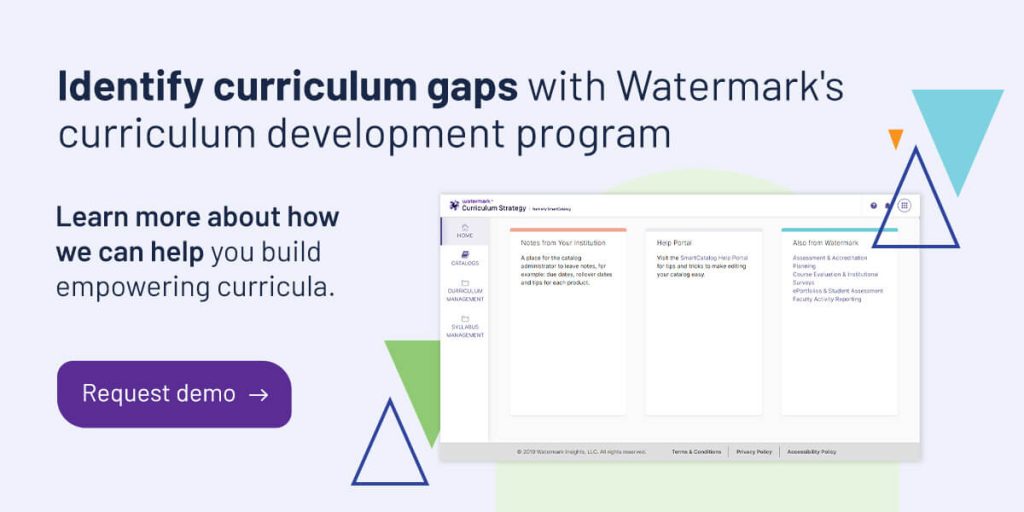




Every learning institution invests time and money in providing students with the best possible education, and much of that starts and ends with the curriculum. A curriculum gap analysis is essential to identify whether the content aligns with the skills and knowledge you expect students to have after completing the curriculum.
Identifying possible curriculum gaps can enhance student learning outcomes and meet institutional program goals. Whether you naturally intuit these gaps with curriculum mapping or glean them from student suggestions in course evaluations, you want to be sure that you’re getting the most out of your curriculum gap analysis solutions.
A gap analysis aims to identify the leaps in instruction students experience when moving between semesters or instructional levels. This analysis examines a list of topics and identifies which of them have yet to be matched with a desired objective, thereby illuminating any unmet standards of the program or curriculum. Higher education institution advisors use a curriculum gap analysis to identify faults in an institution’s instructional foundation so students can adequately build their skills and knowledge.
Conducting instructional gap analyses is imperative for higher education institutions that want to identify what students have learned and fill in curriculum gaps.
Understanding the gaps in your curriculum is essential to addressing them. The different types of curriculum gaps you might encounter include the following:
Intended instruction doesn’t always translate into the actual classroom instruction that takes place on campus. Several disruptors can result in learning disparities that prevent students from obtaining the knowledge and skills they need. For example, schedule interruptions, long breaks in the learning period, extended time away from the classroom, and similar factors can cause gaps.
When these gaps appear, it’s essential to determine the cause and how you, as a higher education decision-maker, can address it. Without a proper analysis, current students and future students may not obtain the necessary skills and knowledge to succeed. This could lead to student dissatisfaction at your institution, higher drop-out rates, lower job placement rates after graduation, and other adverse results for your students and institution.

Prioritizing curriculum adjustments contributes to a more supportive learning environment and better equips students for future education within their programs. Identifying curriculum gaps empowers you to take a student-centered approach to creating a more accessible and comprehensive learning journey.
To complete a curriculum gap analysis, you’ll need lesson plans from the previous year, a pacing guide, and instructional standards for the course. Conversing among colleagues may help instructors understand whether other educators are simply introducing specific criteria or teaching the criteria to mastery. Once instructors have analyzed course standards, they can identify those they did not address in the previous year’s curriculum.
The results of a gap analysis can provide comprehensive insights if you ask the right questions and seek valuable data. To run a curriculum gap analysis, take each topic or standard and ask questions such as:
Before implementing any curriculum improvements, you need to identify the gaps and take a proactive stance on filling them. The following steps can help you identify gaps in your curriculum so you can make the necessary enhancements:
The first step in conducting a successful gap analysis is to review your current curriculum. Analyze your curriculum framework, syllabus, and other relevant information to identify the expected student learning outcomes. From here, you can clarify the skills and knowledge students should possess at the end of the course and set goals around these desired learning outcomes.
Measure your expected learning outcomes against the actual skills and knowledge your students have demonstrated upon completing the course. You can achieve this through various assessment methods, including assignments, projects, and exams. Ensure you use valid assessment methods so you have accurate and actionable results.
Once you’ve compared the expected and actual outcomes, you can start identifying gaps between the two. Analyze your assessment results and compare them to the expected outcomes so you can pinpoint areas where students encounter challenges.
After you complete curriculum gap and overlap analyses, you can apply your findings by making programmatic and curricular improvements. The overlap analysis will help you identify curriculum content’s what, how, and when. Encouraging instructors to share the knowledge they glean from curriculum mapping is essential. Colleagues are invaluable in assessing students and making decisions.
Instructors may adopt the following measures to address curriculum gaps:
An ongoing and successful gap analysis process requires an institution-wide culture of continuous improvement. Every stakeholder can boost student success by encouraging open communication and collaboration among everyone involved, from students to administrators. Celebrate every victory and give students, teachers, and administrators the recognition they deserve for achieving curriculum-based goals.
Establishing clear expectations for addressing curriculum gaps and providing educators with access to professional development opportunities can ensure all students have every chance to succeed and create a more effective curriculum that addresses student needs.
Leveraging data and comprehensive software to conduct a curriculum gap analysis is a process many higher education institutions have implemented. The success of other colleges and universities highlights the possibilities you can uncover with a curriculum gap analysis. Consider these case studies:
Watermark helps you streamline collaboration with an intuitive curriculum management workflow while connecting your curriculum to student learning outcomes. For over two decades, we’ve helped thousands of higher education institutions adopt more efficient ways of collecting data to do what they do best — furthering the success of their students. We have the skills and expertise to develop technologies that support intentional assessment practices within institutions to improve students’ learning.
Watermark Curriculum Strategy includes Student Information System (SIS) integration to connect critical data, handbooks, or catalogs, whether they’re printed or online. Learn how Wilmington University, Colorado Technical University, and Northampton Community College use the Watermark Curriculum Strategy to customize their online catalogs to showcase program outcomes and available courses.
Want to see our curriculum mapping solutions in action? Learn more about how we can help you build empowering curricula, and request a demo today.


























































































































































































































































































































































































Submit this form to schedule a meeting with one of our reps to learn more about our solutions. If you need customer support instead, click here.